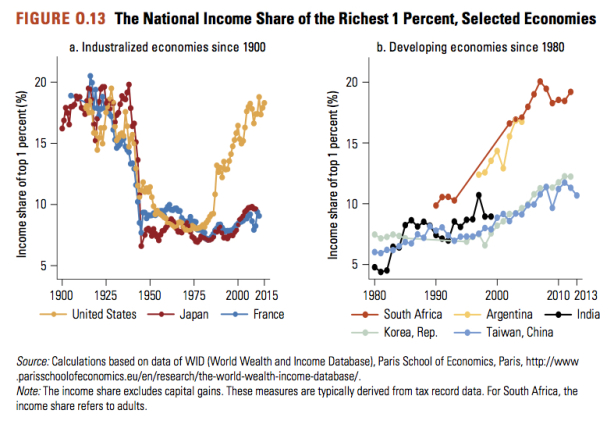From David Ruccio To read National Public Radio’s [ht: ja] article on the latest World Bank report on Poverty and Shared Prosperity: Taking on Inequality, you’d think the problem of global poverty was well on the way to being solved. Is that just wishful thinking? In terms of the headline numbers, the author of the article is correct: In 2013, fewer than 800 million people lived on less than .90 a day. That’s less than 11 percent of the global population. As recently as 1990, about 35 percent of all people lived in such extreme poverty. That means about 1.1 billion people rose out of extreme poverty. But, before we get too excited, there are 3 key issues to keep in mind. First, the World Bank itself follows the presentation of the numbers with a note of caution: Although this represented a noticeable decline, the poverty rate remains unacceptably high given the low standard of living implied by the .90-a-day threshold. That’s right. The threshold is a miserly .90 a day, an update taking into account inflation of the previous limit of a day. If they used anything more reasonable—say, an absolute level of a day or, even better, a relative level of 50 percent of mean income—the level of global poverty would be much higher.* Second, while it’s never mentioned in the article, the actual focus on the World Bank report is inequality.
Topics:
David F. Ruccio considers the following as important: Uncategorized
This could be interesting, too:
tom writes The Ukraine war and Europe’s deepening march of folly
Stavros Mavroudeas writes CfP of Marxist Macroeconomic Modelling workgroup – 18th WAPE Forum, Istanbul August 6-8, 2025
Lars Pålsson Syll writes The pretence-of-knowledge syndrome
Dean Baker writes Crypto and Donald Trump’s strategic baseball card reserve
from David Ruccio
To read National Public Radio’s [ht: ja] article on the latest World Bank report on Poverty and Shared Prosperity: Taking on Inequality, you’d think the problem of global poverty was well on the way to being solved.
Is that just wishful thinking?
In terms of the headline numbers, the author of the article is correct:
In 2013, fewer than 800 million people lived on less than $1.90 a day. That’s less than 11 percent of the global population. As recently as 1990, about 35 percent of all people lived in such extreme poverty.
That means about 1.1 billion people rose out of extreme poverty.
But, before we get too excited, there are 3 key issues to keep in mind.
First, the World Bank itself follows the presentation of the numbers with a note of caution:
Although this represented a noticeable decline, the poverty rate remains unacceptably high given the low standard of living implied by the $1.90-a-day threshold.
That’s right. The threshold is a miserly $1.90 a day, an update taking into account inflation of the previous limit of $1 a day. If they used anything more reasonable—say, an absolute level of $5 a day or, even better, a relative level of 50 percent of mean income—the level of global poverty would be much higher.*

Second, while it’s never mentioned in the article, the actual focus on the World Bank report is inequality. And there the results are, at first glance, bewildering: global inequality has fallen while average within-country inequality is greater now than 25 years ago. But it can be easily explained: Rising incomes in China and India alone, given the size of their populations, have led to a reduction in between-country inequality. However, in many countries, the income share of the top income groups has been expanding—in the United States, of course, but also in Argentina, India, the Republic of Korea, Taiwan, and China. And in South Africa, the top income share roughly doubled over 20 years, to levels comparable to those observed in the United States!
Finally, we need to understand what is actually causing the reported declines in global poverty and inequality. The World Bank singles out five countries—Brazil, Cambodia, Mali, Peru, and Tanzania—as the best performers. And here the NPR article is just plain wrong. The policies the World Bank itself cites are the following “building blocks of success”:
prudent macroeconomic policies, strong growth, functioning labor markets, and coherent domestic policies focusing on safety nets, human capital, and infrastructure.
This is exactly what one would expect from the World Bank: more growth—in other words, business as usual—will solve the problems of poverty and inequality.
The Peruvian example (based on reading the World Bank report and the background research papers) is particularly instructive. The “remarkable” improvement in living conditions among the poor and bottom 40 percent mostly occurred through the labor market (which explains about three-quarters of the reduction in extreme poverty).
What does that mean? Extreme poverty in Peru declined because more people, men and women, joined the labor market. Some left rural areas and migrated to cities; others exited the informal sector and went to work for larger enterprises. In both cases, more Peruvians were forced to have the freedom to sell their ability to work to someone else and, as a result, received more cash income in the form of wages—and then, of course, could use those wages to purchase more commodities.
So, as far as the World Bank is concerned, more Adam Smith development—a faster growing wealth of the nation—was both a condition and consequence of expanding the labor market and reducing poverty. The World Bank’s much-vaunted “shared prosperity” is just another name for more markets and more people working to make profits for a tiny group of employers at the top.
That’s the key point the article missed and the reason the World Bank, in the report, is so keen on celebrating the progress toward achieving the goal of eliminating extreme poverty by 2030.
*In fact, in a World Bank research paper, Shaohua Chen and Martin Ravallion (pdf), compared absolute and relative measures and found “a simultaneous rise in the numbers of relatively poor, alongside the fall in absolute poverty.”
